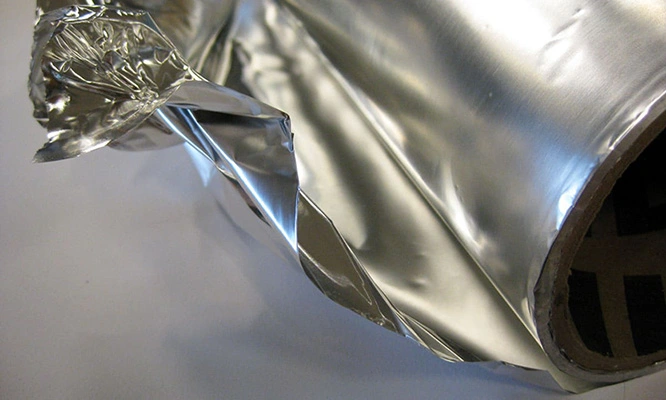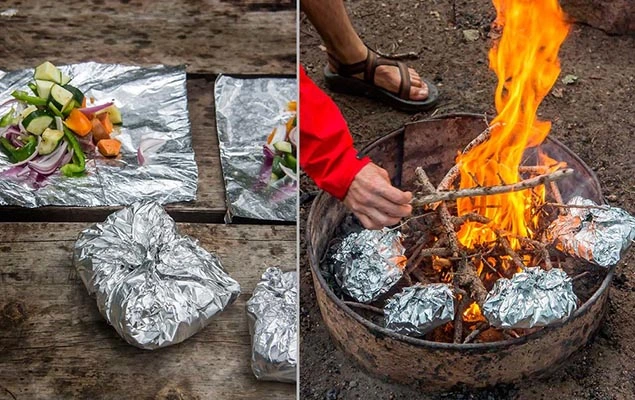Aluminium foil is a versatile and commonly used household item with a variety of cooking and non-cooking applications. From packaging food to reflecting heat, aluminum foil sheets has become a staple in many homes. Aluminum foil consists of thin sheets of aluminum metal that undergo a complex manufacturing process. The aluminum used in foil production is usually of high purity, often containing over 99% aluminum. This purity enhances its performance and allows efficient heat transfer. So, can aluminum foil burn?

To understand whether aluminum foil can burn, you first need to understand the concept of flammability. Flammability refers to the ability of a material to ignite and sustain combustion in the presence of an oxidizing agent, such as oxygen. Several factors influence an object’s flammability, including its composition, structure, and exposure to heat sources.
Reaction Of Aluminium Foil Burn To High Temperature:
Aluminum foil sheets are made of pure aluminium and has special physical properties. Aluminium has a high melting point and requires high temperatures to convert from solid to liquid. In addition, aluminum has good thermal conductivity properties and can distribute heat evenly. These properties play a key role in the non-flammability of aluminium foil.

We need to comprehend how aluminium foil works at high temperatures in order to comprehend the non-flammability of aluminium foil sheets. The first step is to define the distinction between aluminum foil sheets’ melting point and igniting point. The ignition point of aluminum foil is about 2000°C (3632°F), which is substantially higher than its melting point of roughly 660°C (1220°F).
Aluminium foil paper develops an oxide layer at high temperatures as a result of an air reaction involving oxygen and aluminum. The oxide layer serves as a protective barrier and efficiently inhibits further oxidation. Additionally, aluminum foil has a high thermal conductivity, which enables it to swiftly transfer heat to its surroundings and lower the temperature rise of the foil sheet itself.
When Does Aluminum Foil Burn?
The flash point of aluminum foil is well above its melting point, typically above about 600°C (1112°F). Therefore, at high temperatures, aluminium foil paper may burn. According to reliable data and experimental results, the ignition temperature of aluminum foil sheet is usually higher than 700°C (1292°F). This means that in a typical household environment, using household aluminium foil for cooking or baking will not cause it to catch fire because normal cooking temperatures are well below this threshold.
As for the reason why aluminium foil sheet catches fire, we can attribute it to oxidation reaction and heat accumulation. First, aluminium foil will undergo an oxidation reaction in the air. When aluminum foil paper is exposed to high temperatures, it reacts with oxygen in the air to form aluminum oxide. This oxidation reaction is an exothermic process and generates a large amount of heat. Secondly, aluminium foil sheet has good thermal conductivity and can conduct heat quickly. When aluminium foil is exposed to a high-temperature surface or radiated by a heat source, it quickly absorbs heat and conducts it to other parts. If heat accumulates on the foil and exceeds the heat dissipation capacity of the aluminium foil, it will cause the temperature of the aluminum foil sheet to rise and eventually reach the ignition point.
Does Aluminum Foil Burn On Stove?
Aluminum foil usually won’t burn on a regular stove. Aluminium has a relatively high ignition point of approximately 660 degrees Celsius (1220 degrees Fahrenheit). Home kitchen stoves often cannot reach temperatures high enough to ignite aluminum foil. However, if aluminum foil comes into contact with a very hot fire source, such as an industrial furnace or a high-temperature flame, it may eventually begin to burn. But in general home kitchen use, aluminum foil products are safe primarily for food cooking and packaging, as well as other non-combustible applications. However, although aluminum foil does not burn easily on the stove, it can become very hot at high temperatures, so care should be taken when handling hot aluminum foil to avoid burns.
Will Burning Aluminum Foil Release Toxic Substances?
When aluminum foil catches fire at high temperatures, its surface coating (a coating commonly used for food packaging) may burn and release some toxic gases such as carbon monoxide (CO) and sulfur dioxide (SO2). When the human body accidentally inhales these two substances, it may cause poisoning and symptoms such as nausea, vomiting, dizziness, and respiratory discomfort.
What Happens When Aluminum Foil Burn?
1. Appearance and phenomenon: There will be obvious flames on the surface of the foil, and the color of the flame is usually yellow or orange. Flames may spread quickly and the foil may warp or melt.
2. Dangers and consequences: Aluminium foil sheet catching fire may cause the fire to expand and cause the burning of surrounding objects. This can cause the fire to spread and cause serious harm to people and property.
Why Does Aluminum Foil Burn?
The main reason why aluminium foil sheet catches fire is that the foil is in contact with a high-temperature heat source, causing its temperature to rise rapidly. Here are some situations that can cause aluminum foil to catch fire:
- Direct contact with an open flame or furnace body: When foil directly contacts an open flame, a bright stove fire, or a furnace body, the high temperature will be quickly transmitted to the surface of the aluminum foil, increasing the possibility of ignition.
- Hot Spot Concentration: If alloy aluminum foil sheet is pressed against a hot spot area or is in prolonged contact with a hot surface, the heat from the hot spot can cause the temperature of the foil to exceed its ignition point.
- Contact with other flammable substances: The surface of aluminum foil is stained with flammable substances, such as grease or flammable liquids. These substances may react with high-temperature aluminum foil sheets to cause a fire.
What Kind Of Aluminum Foil Is Easy To Catch Fire?
Lower material purity: Low-quality alloy aluminum foil sheets may contain impurities or other metallic components that reduce its antioxidant properties.
Structural unevenness: Low-quality aluminum foil papers may have structural defects during the manufacturing process, such as pores, cracks, or uneven thickness.

Improper surface preparation: There may be a problem with the surface treatment coating or cleaner on the aluminum mental foil, leaving flammable substances behind.
Thinness: Thinner alloy aluminum foil paper is more susceptible to heat sources because thin foil has higher thermal conductivity and is able to transfer heat to the surface more quickly. Therefore, thinner aluminum foil sheet is more likely to catch fire at high temperatures.
Folding or stacking: When alloy aluminum foil is folded or stacked, the incompletely unfolded portions have the potential to create hot spots in an oven or other heating device. This causes the foil to heat up in these areas of concentrated heat, increasing the risk of fire.
Contact with flammable liquids or substances: If mental aluminum foil comes into contact with flammable liquids (such as cooking oils, solvents, etc.) or other flammable materials, these materials may cause fire at high temperatures, causing the aluminum foil to also ignite.
What To Do If Aluminum Foil Burn?
Aluminum foil will not spontaneously ignite under normal conditions of use, but it can cause a fire if it is accidentally mishandled or exposed to extremely high temperatures. Here are some measures and suggestions for dealing with aluminum foil fires:
1. Stay calm and cautious: For individuals, the first step is to stay calm and clear-headed. Do not panic as this may exacerbate the danger or cause greater harm.
2. Never use water to extinguish flames: Since aluminum foil is metal, the use of water may cause the flames to spread and the danger to expand. Because the reaction of water and aluminum produces hydrogen gas, this can cause the fire to intensify or create an explosion hazard. So remember not to put out aluminum foil fires with water.
3. Do not touch it directly with your hands: The surface temperature of aluminum foil is very high when it is burned by fire. Do not touch it directly with your hands or try to grab it. Use appropriate tools or fire extinguishers.
4. Avoid inhaling fumes: Aluminum foil may produce harmful fumes when burning, so inhalation of fumes should be avoided as much as possible. Keep well ventilated and away from sources of fire.
5. Cover the fire source: If possible, use a fire blanket, wet towels, heat-resistant gloves, or other non-flammable materials to seal the fire source on the aluminum foil surface. This helps stop the fire from spreading and reducing oxygen supply.
6. Cut off the oxygen supply: You can try to seal off the contact between the burning aluminum foil and the air, such as turning off the gas valve of the stove or using a fire extinguisher to extinguish the flame.
7. Use a fire extinguisher: If you have an appropriate fire extinguisher and know how to operate it, use a fire extinguisher immediately to put out the flames. Depending on the size of the fire source, choose the appropriate type of fire extinguisher, such as carbon dioxide, chemical foam or powder, and operate it correctly according to the instructions.
8. Seek help immediately: Regardless of the size of the fire, please call the local emergency fire hotline immediately and isolate the source of the fire to ensure life, health and safety.
How To Effectively Prevent Aluminum Foil From Burning?
When used correctly, aluminum alloy foil is a very useful cooking and packaging material. Here are some practical tips for using aluminum foil paper safely and avoiding catching fire:
- Do not place aluminum foil sheets in direct contact with an open flame: Aluminum mental foil has a low ignition point and direct contact with an open flame can cause a fire. So when using aluminum foil on your stove, stove, or grill, make sure you keep it at a distance from open flames.
- Leave space when cooking or packaging food: Aluminum foil expands and contracts during use. In order to prevent the aluminum foil sheets from squeezing the food when it expands due to heat or causing damage when it shrinks due to cold, leave an appropriate amount of space to allow air to circulate.
- Do not use aluminum alloy foil sheets with acidic foods: Aluminum foil sheets may release aluminum ions when in contact with acidic or corrosive foods, which may be harmful to health. Therefore, it is not recommended to use aluminum foil for packaging or cooking acidic foods like lemon juice, tomato sauce, etc.
- Handle hot aluminum alloy foil sheets with care: Use anti-scald gloves, a kitchen utensil, or tools such as long-handled tongs to handle hot aluminum foil to prevent burns.
- Follow usage guidelines: Each brand of aluminum foil may have different usage guidelines, so be sure to read and follow the directions on the product label or packaging.
FAQ:
Can You Burn Aluminum Foil With A Lighter?
The ignition temperature of aluminum foil is relatively high, usually around 650 to 700 degrees Celsius. The flame produced by a lighter is usually not hot enough to reach this temperature. Moreover, aluminum foil is a material with good thermal conductivity, which can quickly dissipate and disperse heat. The oxide layer on the surface of the aluminum foil product can also protect the aluminum foil from the influence of oxygen, preventing the aluminum foil from burning under normal conditions.
Can Aluminum Foil Stop Food From Burning?
Aluminum foil is often used as a thermal barrier in cooking to slow down the cooking process of food, but it does not have the ability to completely prevent food from burning. The main function of aluminum foil is to reflect and disperse heat to ensure that foods are evenly heated while preventing them from burning due to direct contact with a fire source.
Aluminum foil has high thermal conductivity and can effectively absorb and transfer heat, so it can maintain a uniform temperature during cooking. It also catches dripping food juices, preventing them from dripping onto the bottom of the stove or oven and causing a fire.


